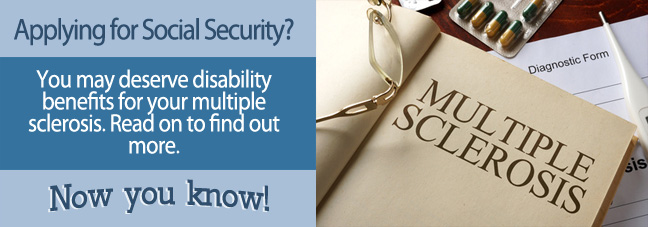If you are applying for disability benefits with Multiple Sclerosis over the age 50, the Social Security Administration (SSA) will use some additional factors to determine if you qualify. These additional factors are called GRID rules, or Medical Vocational Guidelines, and the SSA uses them in their calculations when evaluating eligibility for disability benefits for those who are suffering from Multiple Sclerosis and are over the age of 50.
The SSA’s GRID rules include looking at your age, work history, educational level, and skills. Ultimately, the goal of GRID rules is determining whether or not you are able to work as a result of your condition.
In addition to utilizing the GRID rules, the SSA also evaluates any medical evidence you provide that highlights how your Multiple Sclerosis prohibits you from working (a.k.a., will not allow you to work) for at least the next 12 months. Recent findings from the National MS Society estimate that nearly 1 million people are living with MS in the United States.
Grid Rules and Qualifying for Disability Benefits with Multiple Sclerosis Over 50
The SSA uses GRID rules are if, and when, there is no exact match for your Multiple Sclerosis in the SSA’s Blue Book listing. GRID rules are used by the SSA to determine if your Multiple Sclerosis stops you from working in a previous work and earning a living. More specifically, the SSA’s GRID rules evaluate your likelihood of being retrained for a different occupation if you can no longer sustain your employment—i.e., remain employed—in your most recent job.
The criteria of the “grid” that are utilized when the SSA turns to GRID rules to make a decision regarding your your claim are:
- your age;
- educational level;
- current skills;
- if the skills can be transferred to a new occupation;
- the amount of physical work you are able to do.
These rules accommodate for the fact that, when you have reached the age of 50 years, your work skills will not be as easily transferable to another type of employment. They also accommodate for the fact that employers are usually less likely to employ workers who are over the age of 50.

Medical Requirements for Multiple Sclerosis (MS) and Disability Benefits
The SSA evaluates Multiple Sclerosis under Section 11.00–Neurological in their Blue Book. Your Social Security disability claim (a.k.a., application) for Multiple Sclerosis needs both medical and non-medical evidence such as signs, symptoms, and lab findings to provide the SSA with enough evidence to enable them to assess the effects of your Multiple Sclerosis on your life and working ability.
The medical evidence you will need for your Multiple Sclerosis disability benefits application should include the following:
- medical history,
- lab tests results,
- X-ray results, computerized tomography (CT), magnetic resonance imaging (MRI), and electroencephalography (EEG).
How to Apply For Disability Benefits for MS Over 50
There is another requirement that the SSA needs when you are applying for disability benefits with multiple sclerosis and that is the number of work credits you have accumulated during your working life. If you are over 50 years old you will probably have built up enough work credits to qualify for disability benefits. You will need to have worked for 7 years prior to being diagnosed with multiple sclerosis which means you will have accumulated 28 work credits.
Get Help with your MS Disability Benefits Claim
It is never easy to qualify for disability benefits with Multiple Sclerosis. However, if you seek help from an attorney, your chances of qualifying are far greater than if you try to apply on your own.
Get a Free Case Evaluation Today!
To get connected with an independent, participating attorney who subscribes to our website and can help you with your Multiple Sclerosis disability application, complete the Free Case Evaluation form on this page.
Additional Resources
- What Common Health Problems Occur For People Over 50?
- Top 3 Tips for Applying for Disability with Multiple Sclerosis
- Applying for Social Security Disability Benefits with Multiple Sclerosis (MS)
- How Severe Does My Multiple Sclerosis Have to Be to Get Disability Benefits?
- 8 Free Things Retirees Should Utilize for Frugal Living